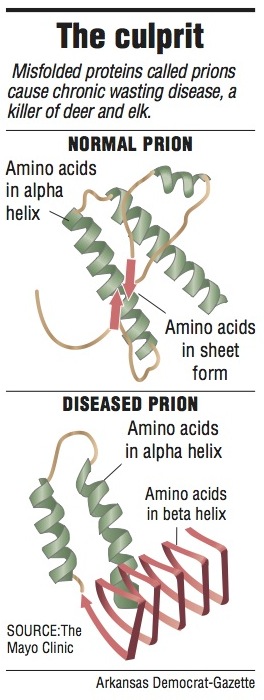
.JPG)
Chronic wasting disease is one of several transmissible spongiform encephalopathies, also known as prion diseases. These rare degenerative brain disorders are characterized by tiny holes that give the brain a spongy appearance. These holes can be seen when brain tissue is viewed under a microscope.

The disease occurs when cellular proteins called prions bend into an abnormal shape (misfold), and then cause neighboring, healthy proteins to do the same. The misfolded proteins collect in the brain and sometimes in other tissue, causing weight loss, coordination problems and behavior changes. There is no cure or vaccine, and the disease is always fatal.
Studies have shown that the disease can be spread both directly (animal-to-animal contact) and indirectly (through soil or other surfaces). The most common mode of transmission from an infected animal is believed to be through saliva, feces and possibly other body secretions. There is strong evidence that people have helped spread the disease over long distances by moving live infected animals and infected carcasses.
Researchers have found no evidence that the disease poses a serious risk to humans or domestic animals. Years of monitoring in affected areas has found no similar disease in people or cattle living there. However, as a precaution, the Centers for Disease Control and Prevention and the Arkansas Department of Health advise that no part of a deer or elk with evidence of chronic wasting disease be consumed by people or other animals.
Infected animals may not show any symptoms. In later stages of the disease, infected animals begin to lose control of bodily functions and display abnormal behavior such as staggering, standing with very poor posture or losing fear of humans. Infected animals lose weight rapidly, appear in very poor condition and often stand in or near water and drink excessively. They may also exhibit drooling or excessive salivation, but these symptoms can be found in other diseases affecting deer and elk.
The best way to help prevent the spread of chronic wasting disease is to not transport any parts of deer or elk from counties where the diesease has been found to other parts of the state. Also, do not place any feed or bait for deer, as this concentrates deer and elk and can help spread the disease.

